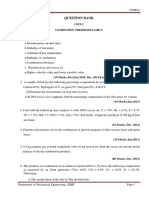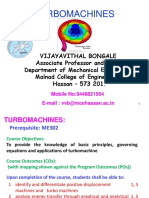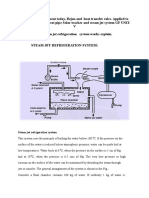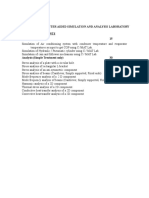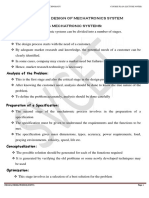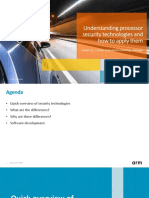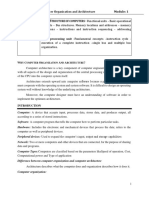Lab Report
Uploaded by
Ninton NawiwaLab Report
Uploaded by
Ninton NawiwaMM 323 Manufacturing Systems
The University of the South Pacific
School of Engineering and Physics
MM 323 – Manufacturing Systems
Lab 6: Flexible Manufacturing System
Lab Session Time: Monday 9-12pm
Student Name: Lorna Palo
Student ID#: S11117386
AIM
The objective of this experiment is to analyze a simple assembly line using FlexSim software and give a
possible solution to improve the factory performance.
EQUIPMENT
Computer Set
FlexSim software
Excel
INTRODUCTION
In any manufacturing factories, the production rate is the one of the main parameter that describes the status
of a company. A high production rate is sign of success; thus factories tend to find solutions to increase the
production rate. An assembly line can be easy to analyze manually if it is small in size. When the factory of
interest has a large assembly line, manual calculations will be time consuming and expensive. Therefore
software are developed to facilitate the analysis in terms of time and cost.
FlexSim is a software used for manufacturing production, assembly line, job shop and many more analysis. It
was founded by Bill Nordgren, Roger Hullinger and Cilff King in 1993 [1]. The software is able to simulate
an assembly of machines in a factory and analyze the system in few minutes for an actual time of shifts in a
week. It gives the possibility to check for any possible solution that can improve the efficiency of the
production line.
This lab is an analysis of a 4-machines production line that uses 2 transportations and produces 2 different
products and the improvement that can be made. All performance for the actual and improved system will bw
discussed in this report.
THEORY
The overall performance of an assembly line depends on the slowest machine. The performance can be
measured by the overall efficiency of the line, the number of unit produced or the production rate.
The efficiency describes the ability of a busyness to produce the highest number of unit output while using
the least amount of resources possible. The aim is to find a balance between the use of resources, the rate of
production and the products quality. The efficiency limits the number of product produced. It can be improved
by costs of the company. It is measured by dividing the employee’s output rate by the standard output rate ad
be expressed in percentage [2].
In this case the efficiency is given by equation 1 below:
Lab Report Page 1
MM 323 Manufacturing Systems
𝑃𝑟𝑜𝑐𝑒𝑠𝑠𝑖𝑛𝑔 𝑡𝑖𝑚𝑒
𝐸𝑓𝑓𝑖𝑐𝑖𝑒𝑛𝑐𝑦 = → 𝑒𝑞𝑢𝑎𝑡𝑖𝑜𝑛 (1)
𝑇𝑜𝑡𝑎𝑙 𝑡𝑖𝑚𝑒
The production rate is the ratio of the output product by the time spent producing them. The production rates can measure
the efficiency of different processes, to determine the performance of the company. They can either increase or decrease
depending on different factors. Managers can analyze how the production rates fluctuates and either improve low
production processors and boost machines that produce higher rates [3]. Production rate is given by equation 2 below:
𝑈𝑛𝑖𝑡 𝑜𝑢𝑡𝑝𝑢𝑡
𝑃𝑟𝑜𝑑𝑢𝑐𝑡𝑖𝑜𝑛 𝑅𝑎𝑡𝑒 = → 𝑒𝑞𝑢𝑎𝑡𝑖𝑜𝑛 (2)
𝑇𝑜𝑡𝑎𝑙 𝑡𝑖𝑚𝑒
EXPERIMENTAL SET UP AND PROCEDURE
The factory processes were modeled in FlexSim workspace. The processing time were assigned to each
processor as well as the transportation time to the forklifts. The model was run for 2400 mins which
corresponds to 8 hrs per shift, 5 days a week. The results were then generated in an excel sheet to be analyzed.
The machine utilization and efficiency were calculated in excel with the recorded data from FlexSim for the
original set up and the improved one.
RESULTS
Table 1: Current factory performance
Time: 2400
Production Processin Efficiency
Product in Unit Unit Rate g
Object Class progress input Output time
Input flow Source 0 0 51 0.0213 0 0
Drilling Processor 1 51 50 0.0208 45.39 0.0189
Milling Processor 1 25 24 0.01 63.75 0.0266
Inspection Processor 0 48 48 0.02 99.84 0.0416
Dispatch Processor 0 48 48 0.02 75.84 0.0316
Transporter
A Transporter 1 50 49 0.0204 0 0
TransporterB Transporter 0 24 24 0.01 0 0
Sink9 Sink 1 48 0 0 0 0
Table 2: Improved solution
Time: 2400
Product in Unit Unit Processing Efficiency Production
Object Class progress input output time rate
Input flow Source 0 0 473 0 0 0.1971
Drilling2 Processor 1 38 37 33.82 0.014 0.0154
Milling Processor 0 36 36 91.8 0.038 0.0150
Inspection Processor 1 470 469 975.52 0.406 0.1954
Dispatch Processor 1 469 468 739.44 0.308 0.1950
Lab Report Page 2
MM 323 Manufacturing Systems
TransporterA Transporter 1 37 36 0 0 0.0150
TransporterB Transporter 0 36 36 0 0 0.0150
Sink9 Sink 1 468 0 0 0 0.0000
Drilling 1 Processor 1 435 434 387.15 0.161 0.1808
Sample Calculation:
𝑃𝑟𝑜𝑐𝑒𝑠𝑠𝑖𝑛𝑔 𝑡𝑖𝑚𝑒 45.39
𝐸𝑓𝑓𝑖𝑐𝑖𝑒𝑛𝑐𝑦 = = = 0.0189
𝑇𝑜𝑡𝑎𝑙 𝑡𝑖𝑚𝑒 2400
𝑈𝑛𝑖𝑡 𝑜𝑢𝑡𝑝𝑢𝑡 50
𝑃𝑟𝑜𝑑𝑢𝑐𝑡𝑖𝑜𝑛 𝑅𝑎𝑡𝑒 = = = 0.0208
𝑇𝑜𝑡𝑎𝑙 𝑡𝑖𝑚𝑒 2400
DISCUSSION
The current assembly line has 4 machines that produce two different products that differ by milling process.
The line uses two forklift to transport parts from drilling to milling or to inspection and from milling to
inspection. The overall efficiency is the efficiency of the last machine which is the dispatcher. When running
the model for 2400 minutes, the efficiency turned out to be 0.0316 or 3.16%. This efficiency value is extremely low
and needs to be improved. The bottleneck of this line is the inspection machine since it receives parts from two
different machines. The low speed of the inspection machine slows down the whole line. With the current line, the
machines produce 48 products in 2400 minutes.
Many possibilities were tested and one of the best solutions if finance may allow is the addition of a second drilling
machine. The improved system has the same machines as the original one with an extra drilling machine. The new
drilling machine added to the system sends parts directly to inspections. It can be noted that there is a huge difference
compared to the original pattern. The overall efficiency has increased to 30% and the line produces 468 products. The
number of product produced was multiplied by ten for the same period of time. This improvement will provide large
benefits to the company.
The possibility of adding a buffer to the line was neglected because of minimum performance improvement.
The idea of adding another inspection machine was also rejected because of very slight changes in the permormance.
Since the bottleneck was notified at the inspection machine, the addition of another inspection machine will speed up
the process however, the products will pile up at the dispatcher.
Therefore, the best choice would be to add a new drilling machine.
CONCLUSION
In conclusion, the aim of the experiment was fulfilled. The analysis of the original factory was done using
FlexSim software and it enabled us to visualize different possibilities to improve the factory performance free
of charge (since it is software based) and time saving. It also gives a closer look on the performance of each
machines, the bottleneck and performance of possible solutions in minutes rather than analyze the actual
system for a whole week. The improvement possibility for this particular factory was selected because of high
performance and cost (1 machine added). The performance of the new line was very high. However, the
improvement depends entirely on the finance and the space of the factory.
Lab Report Page 3
MM 323 Manufacturing Systems
REFERENCE
[1] "FlexSim, Wikipedia," 25 June 2019. [Online]. Available: https://en.wikipedia.org/wiki/FlexSim.
[Accessed 3 September 2019].
[2] K. Will, "Investopedia, Production Efficiency," 19 April 2018. [Online]. Available:
https://www.investopedia.com/terms/p/production_efficiency.asp. [Accessed 3 September 2019].
[3] G. Hanks, "BizFluent, How to calculate production rates," 25 January 2019. [Online]. Available:
https://bizfluent.com/how-5977077-calculate-production-rates.html. [Accessed 3 September
2019].
Lab Report Page 4
You might also like
- Simulation and Visualization of Dynamic Systems Using Matlab, Simulink, Simulink 3D Animation, and SolidworksNo ratings yetSimulation and Visualization of Dynamic Systems Using Matlab, Simulink, Simulink 3D Animation, and Solidworks11 pages
- Question Bank: UNIT:1 Combustion ThermodynamicsNo ratings yetQuestion Bank: UNIT:1 Combustion Thermodynamics14 pages
- 10.2.2 Automated Guided Vehicles: Chap. 10 / Material Transport SystemsNo ratings yet10.2.2 Automated Guided Vehicles: Chap. 10 / Material Transport Systems7 pages
- Mechatronics Unit III and IV Question and AnswersNo ratings yetMechatronics Unit III and IV Question and Answers6 pages
- Refrigeration and Air-Conditioning: Chapter OutlineNo ratings yetRefrigeration and Air-Conditioning: Chapter Outline24 pages
- R19 - Mech - Turbo Machinery - Mechanical - Sample Questions Bank PDFNo ratings yetR19 - Mech - Turbo Machinery - Mechanical - Sample Questions Bank PDF9 pages
- Applied Thermal Engineering Question PapersNo ratings yetApplied Thermal Engineering Question Papers27 pages
- Chain Conveyors and Bucket Elevators: 1 By: Gebrewold TNo ratings yetChain Conveyors and Bucket Elevators: 1 By: Gebrewold T56 pages
- Me8094 Computer Integrated Manufacturing Systems: Diploma, Anna Univ UG & PG CoursesNo ratings yetMe8094 Computer Integrated Manufacturing Systems: Diploma, Anna Univ UG & PG Courses2 pages
- CAE LAB MANUAL - JNTUA III B TechII SEM / SVTM /M RAMA NARASIMHA REDDYNo ratings yetCAE LAB MANUAL - JNTUA III B TechII SEM / SVTM /M RAMA NARASIMHA REDDY96 pages
- Literature Survey: Gclid Cjwkcaiarjjvbraceiwa-Wiqq6Idikaybu6E4Npgogulcgxwxdr3Eien61Ys2Zocz4-Cdgh8 - Q - Fmroccxmqavd - BweNo ratings yetLiterature Survey: Gclid Cjwkcaiarjjvbraceiwa-Wiqq6Idikaybu6E4Npgogulcgxwxdr3Eien61Ys2Zocz4-Cdgh8 - Q - Fmroccxmqavd - Bwe9 pages
- CAMSHAFT (Machining) : A Project Report ONNo ratings yetCAMSHAFT (Machining) : A Project Report ON21 pages
- Chennai Institute of Technolohy, Chennai - 600 069: Department of Mechanical EngineeringNo ratings yetChennai Institute of Technolohy, Chennai - 600 069: Department of Mechanical Engineering8 pages
- D-Alembert Principle and Lagrange's EquationsNo ratings yetD-Alembert Principle and Lagrange's Equations9 pages
- Module 2 Automation and Robotics 18ME732 - Santhosh AcharyaNo ratings yetModule 2 Automation and Robotics 18ME732 - Santhosh Acharya38 pages
- Creating a One-Piece Flow and Production Cell: Just-in-time Production with Toyota’s Single Piece FlowFrom EverandCreating a One-Piece Flow and Production Cell: Just-in-time Production with Toyota’s Single Piece Flow4/5 (1)
- strain criteria and the AS 3600 rectangular stress block. The concrete strength f'c is 40mpa so that γ = 0.85 - 0.007 (40-28) = 0.766No ratings yetstrain criteria and the AS 3600 rectangular stress block. The concrete strength f'c is 40mpa so that γ = 0.85 - 0.007 (40-28) = 0.7662 pages
- Experimental Behavior of In-Organic PET Fiber Reinforcement of Cement ConcreteNo ratings yetExperimental Behavior of In-Organic PET Fiber Reinforcement of Cement Concrete25 pages
- Understanding Processor Security Technologies and How To Apply ThemNo ratings yetUnderstanding Processor Security Technologies and How To Apply Them40 pages
- KTU - CST202 - Computer Organization and ArchitectureNo ratings yetKTU - CST202 - Computer Organization and Architecture22 pages
- Intel Audience Impression Metrics Suite: User GuideNo ratings yetIntel Audience Impression Metrics Suite: User Guide71 pages
- 4 Academics Year - EE & BE 7: Microprocessor and Assembly LanguageNo ratings yet4 Academics Year - EE & BE 7: Microprocessor and Assembly Language13 pages
- Memory Management Processor Management Device Management File Management Security100% (1)Memory Management Processor Management Device Management File Management Security47 pages
- s71200 Motion Control Function Manual en-US en-US PDFNo ratings yets71200 Motion Control Function Manual en-US en-US PDF396 pages
- Chapter 1 Introduction To Computer Architecture: Multiple-ChoiceNo ratings yetChapter 1 Introduction To Computer Architecture: Multiple-Choice17 pages
- Is There A Real Difference Between DSPs and GPUsNo ratings yetIs There A Real Difference Between DSPs and GPUs18 pages
- Algorithms: Iob-Cache: A High-Performance Configurable Open-Source CacheNo ratings yetAlgorithms: Iob-Cache: A High-Performance Configurable Open-Source Cache20 pages
- Simulation and Visualization of Dynamic Systems Using Matlab, Simulink, Simulink 3D Animation, and SolidworksSimulation and Visualization of Dynamic Systems Using Matlab, Simulink, Simulink 3D Animation, and Solidworks
- 10.2.2 Automated Guided Vehicles: Chap. 10 / Material Transport Systems10.2.2 Automated Guided Vehicles: Chap. 10 / Material Transport Systems
- Refrigeration and Air-Conditioning: Chapter OutlineRefrigeration and Air-Conditioning: Chapter Outline
- R19 - Mech - Turbo Machinery - Mechanical - Sample Questions Bank PDFR19 - Mech - Turbo Machinery - Mechanical - Sample Questions Bank PDF
- Chain Conveyors and Bucket Elevators: 1 By: Gebrewold TChain Conveyors and Bucket Elevators: 1 By: Gebrewold T
- Me8094 Computer Integrated Manufacturing Systems: Diploma, Anna Univ UG & PG CoursesMe8094 Computer Integrated Manufacturing Systems: Diploma, Anna Univ UG & PG Courses
- CAE LAB MANUAL - JNTUA III B TechII SEM / SVTM /M RAMA NARASIMHA REDDYCAE LAB MANUAL - JNTUA III B TechII SEM / SVTM /M RAMA NARASIMHA REDDY
- Literature Survey: Gclid Cjwkcaiarjjvbraceiwa-Wiqq6Idikaybu6E4Npgogulcgxwxdr3Eien61Ys2Zocz4-Cdgh8 - Q - Fmroccxmqavd - BweLiterature Survey: Gclid Cjwkcaiarjjvbraceiwa-Wiqq6Idikaybu6E4Npgogulcgxwxdr3Eien61Ys2Zocz4-Cdgh8 - Q - Fmroccxmqavd - Bwe
- Chennai Institute of Technolohy, Chennai - 600 069: Department of Mechanical EngineeringChennai Institute of Technolohy, Chennai - 600 069: Department of Mechanical Engineering
- Module 2 Automation and Robotics 18ME732 - Santhosh AcharyaModule 2 Automation and Robotics 18ME732 - Santhosh Acharya
- Creating a One-Piece Flow and Production Cell: Just-in-time Production with Toyota’s Single Piece FlowFrom EverandCreating a One-Piece Flow and Production Cell: Just-in-time Production with Toyota’s Single Piece Flow
- strain criteria and the AS 3600 rectangular stress block. The concrete strength f'c is 40mpa so that γ = 0.85 - 0.007 (40-28) = 0.766strain criteria and the AS 3600 rectangular stress block. The concrete strength f'c is 40mpa so that γ = 0.85 - 0.007 (40-28) = 0.766
- Experimental Behavior of In-Organic PET Fiber Reinforcement of Cement ConcreteExperimental Behavior of In-Organic PET Fiber Reinforcement of Cement Concrete
- Understanding Processor Security Technologies and How To Apply ThemUnderstanding Processor Security Technologies and How To Apply Them
- KTU - CST202 - Computer Organization and ArchitectureKTU - CST202 - Computer Organization and Architecture
- Intel Audience Impression Metrics Suite: User GuideIntel Audience Impression Metrics Suite: User Guide
- 4 Academics Year - EE & BE 7: Microprocessor and Assembly Language4 Academics Year - EE & BE 7: Microprocessor and Assembly Language
- Memory Management Processor Management Device Management File Management SecurityMemory Management Processor Management Device Management File Management Security
- s71200 Motion Control Function Manual en-US en-US PDFs71200 Motion Control Function Manual en-US en-US PDF
- Chapter 1 Introduction To Computer Architecture: Multiple-ChoiceChapter 1 Introduction To Computer Architecture: Multiple-Choice
- Algorithms: Iob-Cache: A High-Performance Configurable Open-Source CacheAlgorithms: Iob-Cache: A High-Performance Configurable Open-Source Cache


